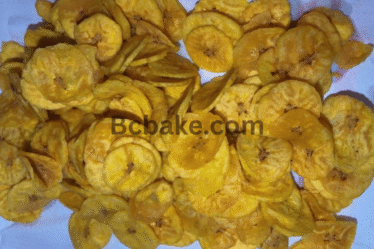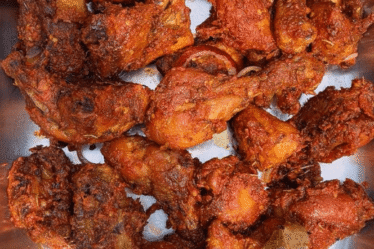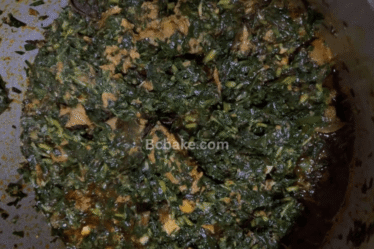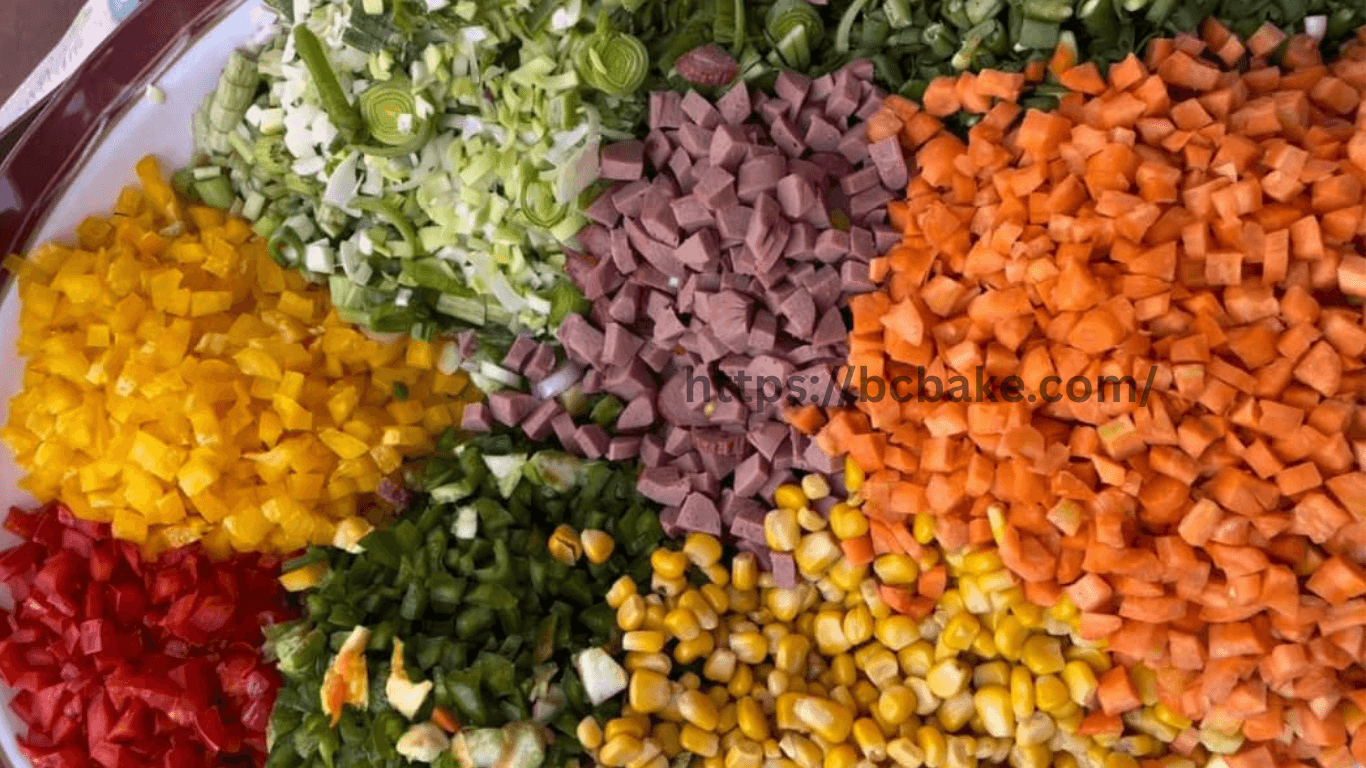
There’s nothing quite as comforting as a warm bowl of fried rice, and this fried rice vegetables recipe is a delicious way to enjoy it at home.
Made with fresh, colorful vegetables and simple pantry sauces, it’s a dish that’s both nourishing and incredibly easy to make.
Fried rice has always been a go-to comfort food around the world, and the best part is that you can easily customize it with whatever vegetables you have on hand.
Whether you’re cooking for a busy weeknight dinner, meal prepping for the week, or simply craving a light yet filling bowl of fried rice, this recipe will hit the spot.
What vegetables are put in fried rice?
One of the best things about fried rice is how flexible it can be, you can mix and match vegetables depending on what you have in your kitchen.
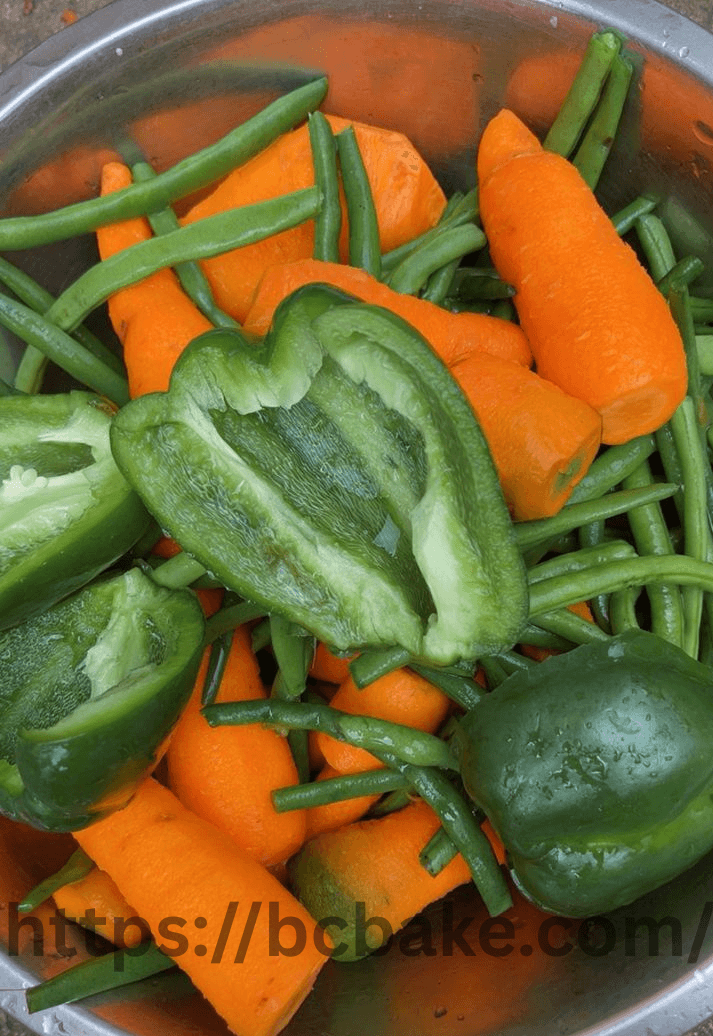
Traditionally, fried rice includes a colorful mix of crunchy and soft veggies that balance both flavor and texture.
Here are some popular choices:
- Carrots: add a touch of sweetness and a pop of color.
- Green beans: bring crunch and freshness.
- Peas: soft, slightly sweet, and quick to cook.
- Bell peppers: add vibrant color and a mild sweetness.
- Cabbage: gives a light crunch and bulks up the dish.
- Corn kernels: provide a subtle sweetness.
- Spring onions (scallions): used both for stir-frying and garnish.
You can also add other vegetables like broccoli, zucchini, or mushrooms for variety.
The key is to chop them into small, even pieces so they cook quickly on high heat and blend well with the rice.
How to Cut Veggies for Fried Rice
The way you cut vegetables makes a big difference in how your fried rice turns out.
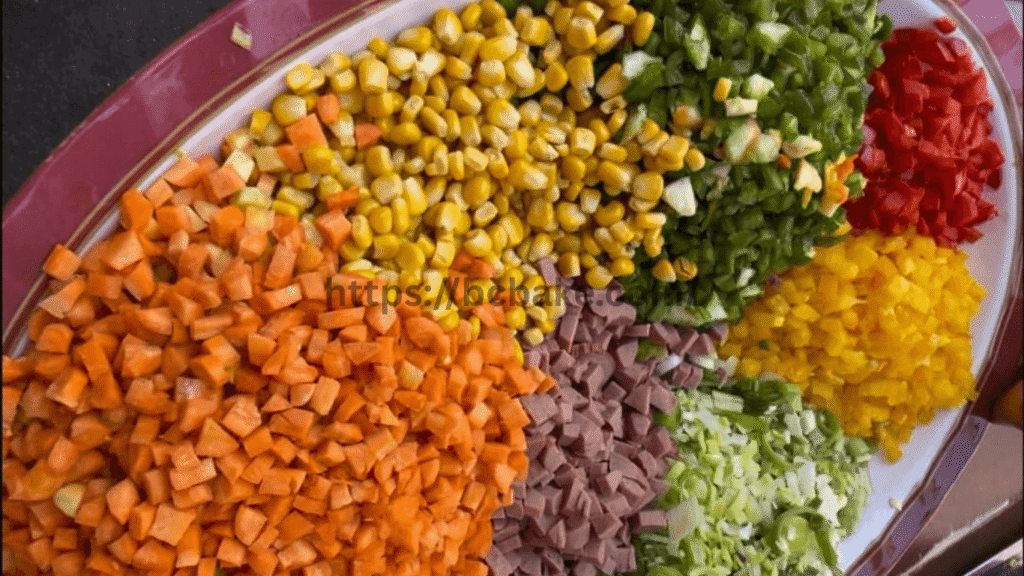
Since fried rice cooks quickly on high heat, the vegetables should be cut into small, even pieces so they cook fast and blend well with the rice.
Here are some tips:
- Carrots & beans: Dice them into small cubes or thin matchstick strips.
- Bell peppers: Chop into small, bite-sized squares.
- Cabbage: Shred finely into thin strips so it softens quickly.
- Onions & spring onions: Slice thinly; reserve the green tops for garnish.
- Garlic & ginger: Mince or grate for even distribution of flavor.
- Peas & corn: These can be added as they are, no cutting needed.
The goal is to keep the pieces uniform in size so they cook evenly and give every spoonful a mix of rice and vegetables.
Fried Rice Vegetables Recipe
Colorful, crunchy & packed with flavor, my secret to the perfect fried rice veggies.
If you’ve been looking for a simple way to make your fried rice taste like your favorite restaurant version, this is it in the video.
Nothing beats the aroma of fresh veggies sizzling in the pot. Fresh vegetables, a quick stir-fry, and just the right blend of flavors.
This fried rice recipe is colorful, healthy, and absolutely delicious. It is a proof that healthy eating doesn’t have to be boring.
To make this delicious fried rice with vegetables, you only need a few simple ingredients that you probably already have in your pantry and fridge.
Here’s what you’ll need:
- Cooked/Parboiled rice: A properly cooked rice works best because it’s less sticky and gives the perfect fried rice texture.
- Mixed vegetables: A colorful mix of carrots, beans, peas, bell peppers, corn, and cabbage.
- Onion: Adds sweetness and depth of flavor.
- Garlic & ginger: For aroma and a subtle kick.
- Spring onions: Used both while cooking and as a garnish.
- Soy sauce: Brings the classic umami taste.
- Sesame oil: For a nutty flavor and authentic touch.
- Salt & black pepper: To season and balance flavors.
- Cooking oil: Any neutral oil with a high smoke point, such as sunflower or canola oil.
Optional: chili sauce for heat, scrambled eggs for extra protein, or tofu/paneer for a heartier meal.
Step-by-Step Instructions to make Stir Fried Rice Vegetables
Follow these simple steps to make a flavorful bowl of vegetable fried rice at home;
See also: Best Fried Rice Recipe Chicken for Family Dinners and Special Occasions
1. Cook the rice
Boil rice in lightly salted water until just cooked (fluffy, not sticky). Drain if needed and set aside to cool slightly.
2. Prepare the vegetables
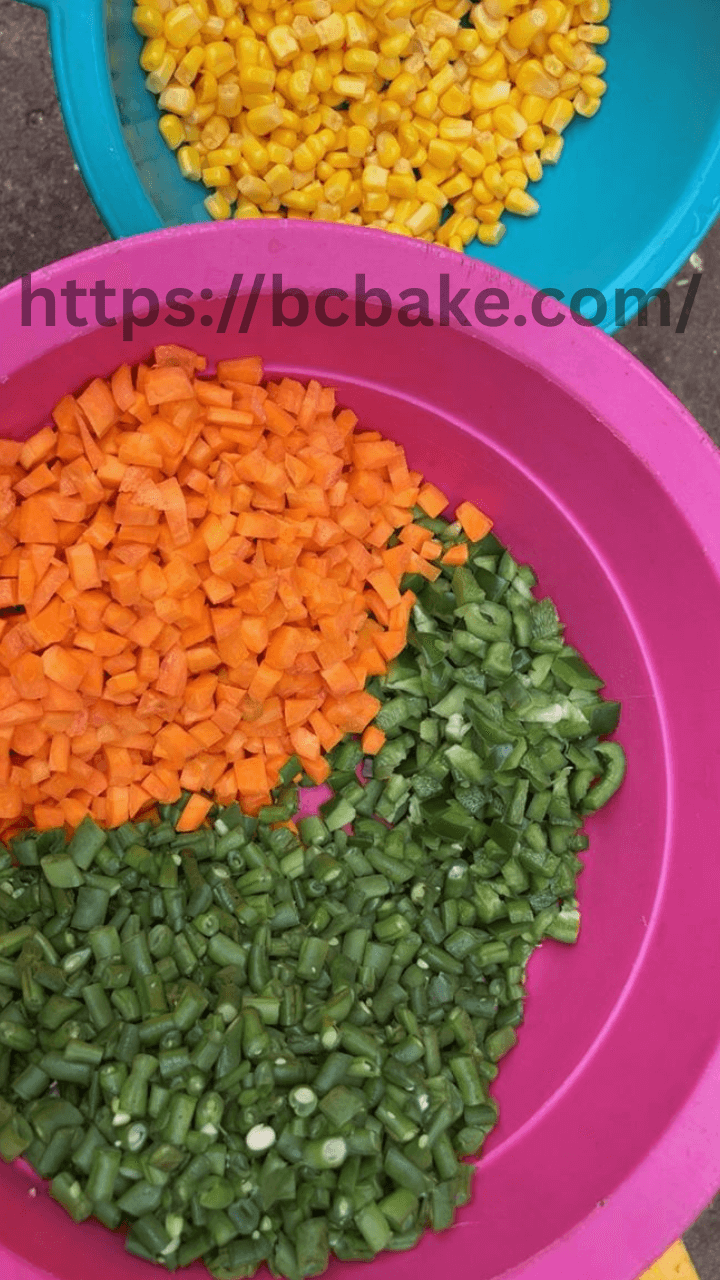
Wash properly and finely chop all the vegetables into small, even pieces. Slice spring onions, mince garlic, and grate ginger for maximum flavor.
3. Heat oil in a pot
Add cooking oil to a hot pot or pan. Swirl it around to coat the surface.
4. Stir-fry aromatics
Add garlic, ginger, and onions. Stir-fry quickly until they release their aroma.
5. Add the vegetables
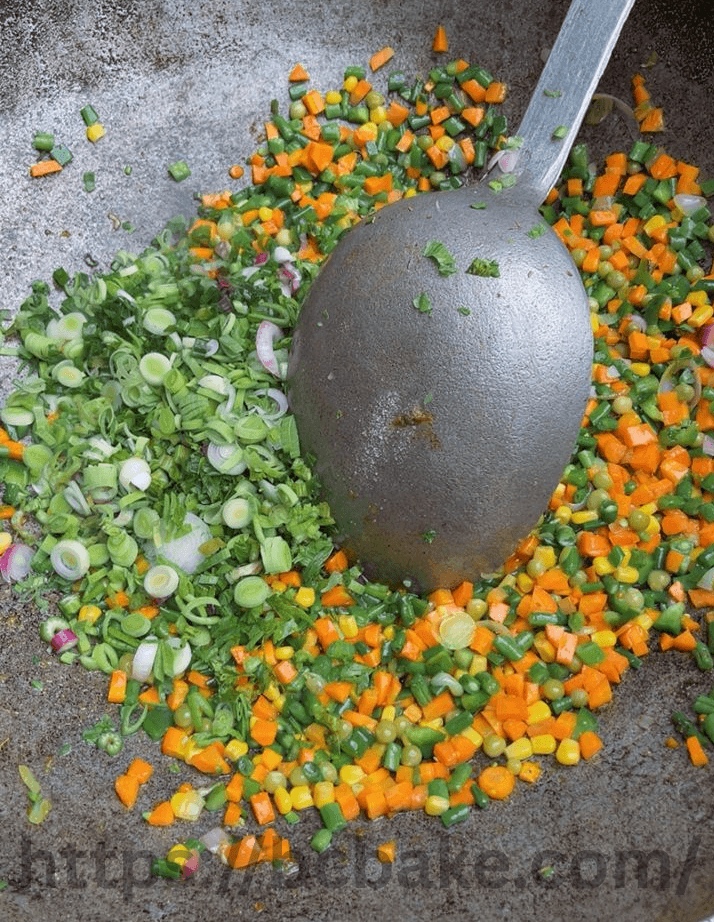
Put in the carrots, beans, peas, bell peppers, and cabbage. Cook on low heat, stirring continuously so they stay crisp and colorful.
6. Mix in the rice
Add the cooked rice to the pot. Use a spatula to gently combine it with the vegetables.
7. Season well and stir fry
Pour in soy sauce and sesame oil. Sprinkle salt and pepper to taste. Stir-fry for a couple of minutes until everything is well mixed.
Stir-fry everything together for 2–3 minutes, ensuring the rice is coated with sauce and heated through.
8. Garnish and enjoy
Finish with chopped spring onion greens. Serve hot as a light meal or pair with your favorite side dishes.
Variations of fried rice vegetables to Try
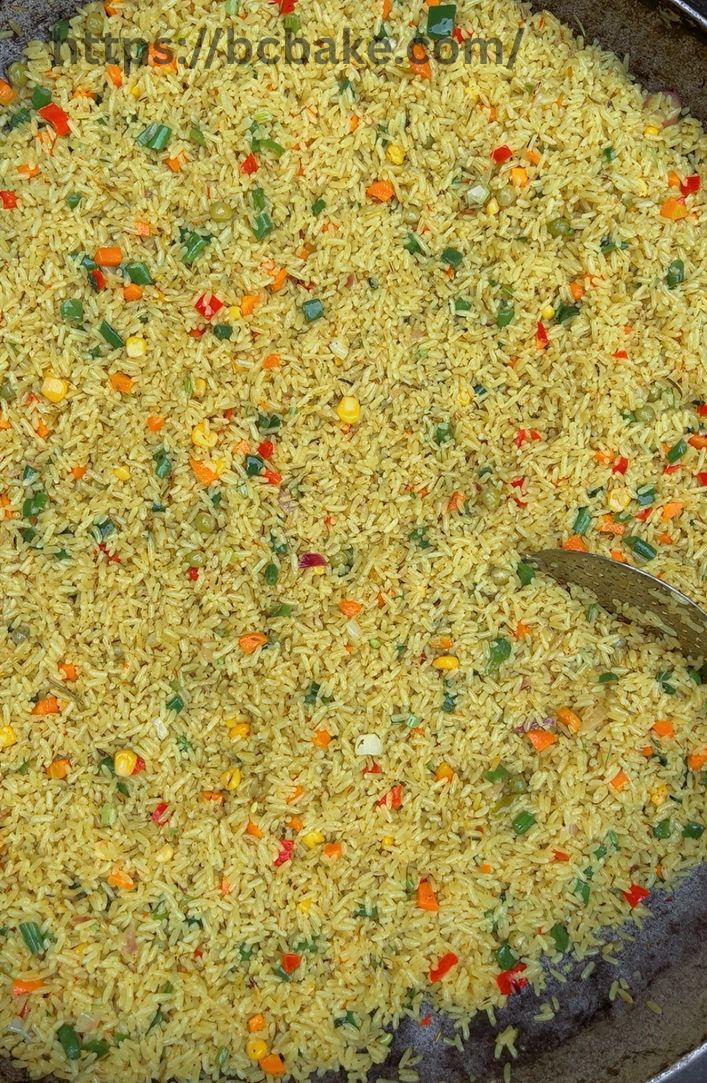
One of the best things about fried rice is how adaptable it is, you can easily change the flavors and ingredients to suit your mood or what you have on hand.
Here are some tasty variations you can try:
Egg Fried Rice
Scramble eggs in the wok first, then mix them into the rice and vegetables for extra protein.
Spicy Fried Rice
Add chili sauce, red chili flakes, or sriracha for a fiery kick.
Garlic Fried Rice
Use extra garlic for a bold, aromatic flavor that pairs well with Asian curries.
Paneer or Tofu Fried Rice
Toss in cubes of paneer or tofu for a hearty, vegetarian-friendly option.
Chicken or Shrimp Fried Rice
Stir-fry bite-sized pieces of chicken or shrimp before adding the vegetables and rice.
Vegan Fried Rice
Skip eggs and animal proteins, and use soy sauce or tamari for seasoning.
Thai-Style Fried Rice
Add a splash of lime juice, fish sauce (optional), and fresh basil for a fragrant twist.
These variations of vegetable fried rice make it easy to enjoy fried rice in different ways without ever getting bored.
What are the full ingredients for fried rice?
The beauty of fried rice lies in its simplicity, you don’t need a long list of fancy ingredients to make it delicious.
Read more: Peppered Chicken Recipe: How to Make the Irresistible Nigerian Party Favorite at Home
With just rice, vegetables, and a few basic seasonings, you can whip up a flavorful meal in minutes.
Here’s a complete list of the essentials:
- Rice: The base of the dish, cooked until fluffy.
- Vegetables: Common choices include carrots, beans, peas, bell peppers, corn, and cabbage.
- Onion: Adds sweetness and depth.
- Garlic and ginger: For aroma and a touch of spice.
- Spring onions: Used both during cooking and as a garnish.
- Soy sauce: Brings savory umami flavor.
- Sesame oil: Adds a nutty aroma (optional but recommended).
- Salt and black pepper: To balance and season the dish.
- Cooking oil: Neutral oil like sunflower or vegetable oil works best.
Optional extras: chili sauce for spice, eggs for protein, or tofu, chicken, or shrimp for a heartier version.
With these simple ingredients, you’ll have everything you need to prepare a restaurant-style fried rice right at home.
Conclusion on Stir fried Rice Vegetables
This fried rice vegetables recipe is proof that you don’t need fancy ingredients to make a wholesome and flavorful meal.
With just a handful of fresh vegetables, rice, and pantry staples, you can create a dish that’s perfect for busy weeknights or even a special weekend dinner.
This fried rice with vegetables recipe is easy enough for beginners yet delicious enough to impress family and friends. Now it’s your turn to give it a try.
Have you tried making fried rice at home? What are your favorite vegetables or add-ins? do you keep it simple with veggies, or do you add eggs, chicken, or tofu?
Share your version in the comments below – We’d love to hear from you.
If you enjoyed this recipe, don’t forget to save it for later, share it with friends, and subscribe to our blog for more quick and tasty recipes. Your support helps us bring more delicious ideas straight to your kitchen.
FAQs on Fried Rice Vegetables Recipe
When it comes to making fried rice, many readers often wonder about the best vegetables to use, how to enhance the flavor, and how different cultures prepare this dish.
Here are answers to some of the most common questions about fried rice;
1. Can I put cabbage in fried rice?
Yes! Cabbage is a great addition to fried rice. It adds crunch, freshness, and a subtle sweetness that balances the savory flavors.
Just shred it finely and stir-fry it along with other vegetables.
2. What vegetables are in Nigerian fried rice?
Nigerian fried rice often includes carrots, peas, green beans, and sweet corn. Sometimes bell peppers and liver are added for extra flavor and texture.
It’s usually cooked with curry powder for a rich, distinctive taste.
3. What vegetables are in Thai fried rice?
Thai fried rice typically uses vegetables like onion, tomatoes, carrots, and scallions.
It’s flavored with fish sauce, soy sauce, garlic, and sometimes Thai basil, giving it a unique fragrance and taste.
4. How to get flavour in fried rice?
For maximum flavor, stir-fry on high heat, use aromatics like garlic, ginger, and onion, and season with soy sauce, sesame oil, or chili sauce.
Adding a splash of oyster sauce or fish sauce can also deepen the flavor. Fresh spring onions at the end bring extra brightness.
5. Which vegetables are put in fried rice?
The most common vegetables are carrots, peas, beans, bell peppers, cabbage, corn, and spring onions.
You can mix and match depending on what you have available.
6. What vegetables go in chicken fried rice?
Chicken fried rice usually includes carrots, peas, bell peppers, and spring onions.
Some variations also add cabbage or corn for extra crunch and color.
7. Can you put mixed veggies in fried rice?
Absolutely. Frozen or fresh mixed vegetables work perfectly in fried rice. They’re convenient and add a nice variety of textures and colors in one go.
Just be sure to stir-fry them properly so they don’t turn mushy.
